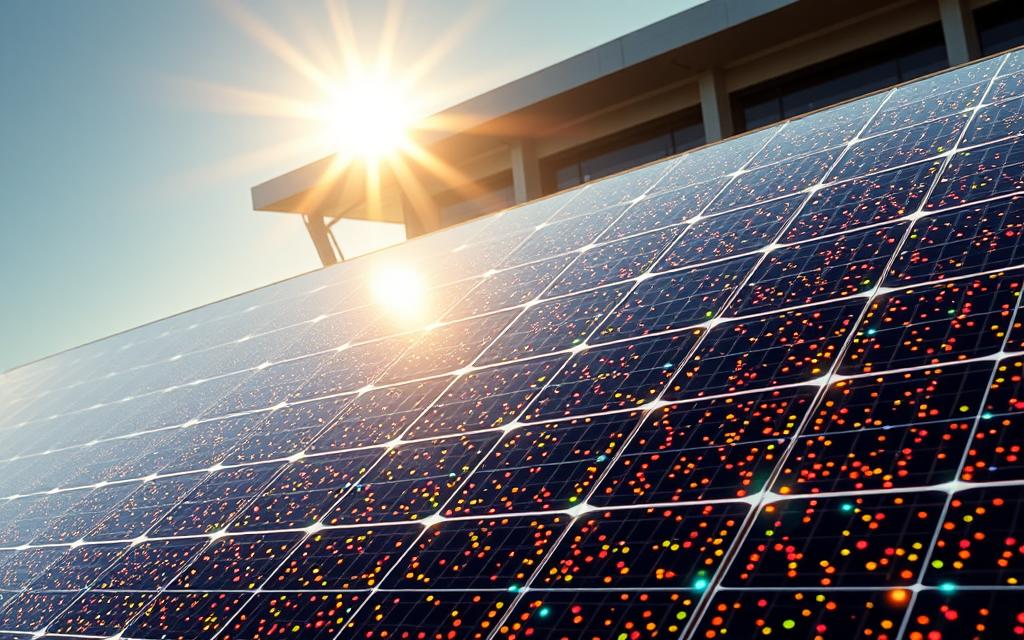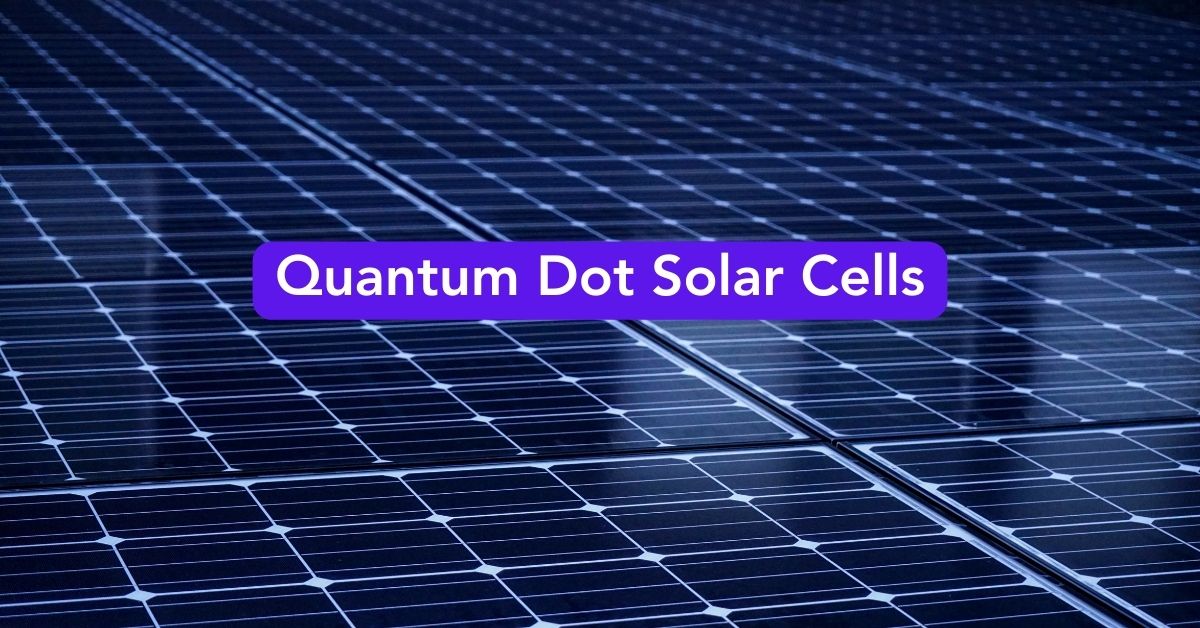In the world of renewable energy, a new technology – quantum dot solar cells- has come to light. These devices use tiny semiconductor particles called quantum dots. They change how we catch and use solar energy. This article will explore the science behind these cells, their structure, and how they work.

Key Takeaways
- Quantum dot cells use special tiny particles to improve how they turn sunlight into energy.
- The size of these particles can be changed to catch sunlight better and make more energy.
- These cells can absorb light well, even with thin layers. This could make them cheaper to make.
- They can also make more energy from sunlight by using special processes.
- Quantum cells could be used in many ways, like on buildings or in wearable tech.
Introduction to Quantum Dot Solar Cells
Quantum dots are a new technology for solar cells. They are tiny semiconductor crystals. Their size leads to special properties because of quantum mechanics.
What are Quantum Dots?
Quantum dots are tiny crystals, 2 to 10 nanometers big. Their size means electrons and holes act differently. This is called quantum confinement.
This confinement lets us adjust the material’s bandgap. The bandgap decides what wavelengths of light the material can turn into electricity.
Related: What are Qcells Solar Panels?
Potential of Quantum Dots in Solar Energy Conversion
- Tunable bandgap: We can change the bandgap of quantum dots. This lets them absorb more light, capturing a wider range of the solar spectrum.
- High absorption coefficients: Quantum dots absorb light very well. This means we can use thinner layers in solar cells. It saves money and boosts performance.
- Multiple exciton generation: Sometimes, quantum dots can make more than one electron-hole pair from one photon. This could make solar cells more efficient.
- Hot carrier extraction: Quantum dots help get rid of “hot” carriers quickly. This can lead to higher voltages and better efficiency in solar cells.
Quantum dots have special properties. They make quantum dot solar cells more efficient than old silicon-based ones.
Quantum Dot Solar Cell Structure
Quantum dot solar cells are a special kind of solar panel. They use tiny particles called quantum dots. These dots are made of semiconductor material and are placed between layers that help move electrons and holes.
These solar cells can be made in different ways. For example, colloidal quantum dot solar cells use a thin film made from dots in a solution. This makes them affordable and easy to make. Hybrid heterojunction solar cells mix quantum dots with other materials like silicon or perovskites. This improves their performance and makes them more stable.
| Solar Cell Architecture | Key Features |
|---|---|
| Colloidal Quantum Dot Cells | Combines quantum dots with other semiconductor materials Enhances solar cell performance and stability Utilizes the tunable bandgap and high absorption coefficients of quantum dot nanoparticles. |
| Hybrid Heterojunction Solar Cells | Combines quantum dots with other semiconductor materials Enhances solar cell performance and stability Utilizes the tunable bandgap and high absorption coefficients of quantum dot nanoparticles. |
Quantum dot solar cells can be made in many ways. This makes them great for many uses. They can be used in building-integrated photovoltaics and even in portable and wearable electronics.

How Do Quantum Dot Solar Cells Work?
Quantum dot solar cells work by using the photovoltaic effect. This effect happens when photons are absorbed by the quantum dots. This creates electron-hole pairs or excitons.
Photon Absorption and Exciton Generation
Sunlight hitting the quantum dots in the solar cell excites the electrons. This makes them jump to a higher energy level. This jump creates an electron-hole pair or exciton.
Quantum dots can absorb photons efficiently because of their size. They can also create more than one exciton from a single photon. This makes the solar cells work better.
Charge Separation and Transport
After excitons are made, they must be separated into free electrons and holes. Then, they need to be moved to the electrodes to create electricity. This is key to how quantum dot solar cells work.
The design of the solar cell helps with this process. It uses layers to move the electrons and holes. This leads to the photovoltaic effect and electricity generation.
Understanding how quantum dot solar cells work helps us make them better. We can improve their performance. This could lead to more use of these cells in renewable energy.
Quantum Dot Solar Cell Efficiency
Quantum dot solar cells can go beyond the usual limits of solar energy conversion. They use special effects like multiple exciton generation and hot carrier extraction. These new solar technologies use quantum dots to open up new ways to turn sunlight into electricity.
Factors Affecting Efficiency
Many things affect how well quantum dot solar cells work. The bandgap of quantum dots can be changed to better catch sunlight. This means they can use more of the sun’s energy.
Quantum dots also absorb light very well. This helps them turn more sunlight into electricity. The way quantum dots work also helps in using more energy from each photon.
| Factor | Impact on Efficiency |
|---|---|
| Tunable Bandgap | Enables optimized light absorption and energy conversion |
| High Absorption Coefficients | Enhances photon harvesting and energy capture |
| Quantum Confinement Effects | Facilitates multiple exciton generation and hot carrier extraction |
By fine-tuning these factors, scientists and engineers are making quantum dot solar cells more efficient. This is helping to find cleaner, greener ways to make energy.
Quantum Dot Solar Cell Materials
Quantum dot solar cells use many different materials. These include lead sulfide (PbS), cadmium telluride (CdTe), indium phosphide (InP), perovskite quantum dots, and organic-inorganic hybrid quantum dots. Each material has special properties that help make quantum dot solar cells work well.
Lead sulfide (PbS) quantum dots are well-studied. They have a bandgap that can be changed, absorb light well, and move charges efficiently. They can be made in solution, which is good for making large, affordable solar cells.
Cadmium telluride (CdTe) is another important material. CdTe quantum dots absorb light well and separate charges efficiently. This makes them great for high-performance solar cells.
| Material | Bandgap Range (eV) | Absorption Coefficient (cm-1) | Charge Transport Properties |
|---|---|---|---|
| Lead Sulfide (PbS) | 0.8 – 2.0 | 104 – 105 | High electron and hole mobility |
| Cadmium Telluride (CdTe) | 1.5 – 2.2 | 104 – 105 | Efficient charge separation and transport |
| Indium Phosphide (InP) | 1.3 – 2.0 | 104 – 105 | High electron and hole mobility, low defect density |
Indium phosphide (InP) quantum dots are also interesting. They have a bandgap that can be changed, absorb light well, and have few defects. This makes them good for making efficient solar cells.
New materials like perovskite quantum dots and organic-inorganic hybrid quantum dots are also being explored. They offer new ways to improve quantum dot solar cells.
“The diverse range of quantum dot materials enables the tuning of optical and electrical properties, paving the way for highly efficient and versatile solar cell designs.”

Advantages of Quantum Dot Solar Cells
Quantum dot solar cells have many benefits that make them exciting for renewable energy. They can adjust their bandgap to better absorb light and convert it into energy. This means they can use the sun’s energy more efficiently.
These cells also have high absorption coefficients. This allows them to be made thin, which saves materials and money. Their ability to absorb light well also boosts their energy conversion efficiency.
Tunable Bandgap
Quantum dots can change their bandgap, which is key for solar energy. By tweaking the dots’ size and makeup, scientists can match the bandgap to the sun’s energy. This maximizes how much energy they can capture.
High Absorption Coefficients
Quantum dot solar cells absorb light very well, thanks to their high absorption coefficients. This lets them be made thin, saving on materials and costs. Their light absorption also helps them convert energy more efficiently.
These cells also have the chance to generate more than one exciton and extract hot carriers. This boosts their energy conversion even more. Plus, they’re easy to make, flexible, and can be scaled up for many uses.

Quantum Dot Solar Cell Fabrication
Making quantum dot solar cells is a complex process. It starts with creating tiny, nanoscale particles called colloidal quantum dots. These particles have special properties that make them great for turning sunlight into electricity.
One big plus of quantum dot solar cells is how they can be made. They can be produced using methods like spin-coating or roll-to-roll manufacturing. This makes them easy and cheap to make in large amounts. It’s a big difference from the expensive ways traditional silicon solar cells are made.
| Fabrication Technique | Advantages |
|---|---|
| Spin-coating | Rapid, high-throughput deposition of quantum dot thin films |
| Roll-to-roll manufacturing | Scalable, continuous production of quantum dot solar cells |
Because they are made in solution, quantum dot solar cells can use many different materials. This includes organic layers and metal oxides. This flexibility makes them even more affordable and scalable.
“The solution-processing capabilities of quantum dot solar cells open up new avenues for large-scale, cost-effective manufacturing, positioning them as a highly promising option for the future of renewable energy.”
As scientists keep working on quantum dot solar cells, they’re finding new ways to make them better. They’re looking at ways to improve their performance and reliability. This could lead to them being used in many places, from buildings to portable devices.
Applications of Quantum Dot Solar Cells
Quantum dot solar cells have special properties. They can change color and absorb a lot of light. This makes them great for many uses. They are especially useful in building integrated photovoltaics and portable/wearable electronics.
Building-Integrated Photovoltaics
These solar cells are perfect for buildings. They can be made flexible, clear, and efficient. This lets them blend into building materials like windows and roofs.
They help make buildings more energy-efficient. This reduces the carbon footprint and energy use in cities.
Portable and Wearable Electronics
Quantum dot solar cells are light, flexible, and can be clear. They’re ideal for portable electronics and wearable devices. They can power everything from phones to smart textiles.
This technology could change how we power our devices. It makes self-powered, flexible solar cells possible. This could change our digital lives forever.
“Quantum dot solar cells have the potential to transform the way we power our buildings, gadgets, and even our clothes, ushering in a new era of sustainable, efficient, and truly integrated energy solutions.”
Challenges and Limitations
Quantum dot solar cells are very promising, but they face many challenges. One big issue is their stability and how long they last. They can lose performance over time because of air, moisture, and heat.
Another big problem is the toxicity of some materials used in these cells. This is a major concern for the environment. It’s important to find ways to make these cells safer for our planet.
Stability and Lifetime Concerns
One major problem with quantum dot solar cells is their short lifespan. They can get worse over time because of many factors. These include the environment, how the materials break down, and how to keep them safe.
Fixing these issues is key for quantum dot solar cells to become more popular. They have a lot of potential, but they need to last longer and work better.
Toxicity and Environmental Impact
Another big challenge is the toxicity of some materials in these cells. Some materials, like cadmium or lead, can be harmful to health and the environment. It’s important to find safer alternatives.
Researchers are working hard to find better materials and ways to keep these cells safe. They want to make sure these solar cells are good for our planet.
To solve these problems, scientists are working on many things. They’re trying to make these cells last longer and be safer. They’re also looking for new materials and better ways to make these cells.
Improving these areas is crucial for quantum dot solar cells to become a big success. They have a lot of potential, but they need to overcome these challenges first.
“The long-term stability and environmental impact of quantum dot solar cells are crucial factors that must be addressed for this technology to reach its full potential.”
Conclusion
Quantum dot solar cells are changing the future of solar energy. They promise to make using the sun’s power more efficient. These cells are flexible, and scalable, and could lead to a greener energy future.
Quantum dots have special properties that make these solar cells better than old silicon ones. Scientists are working hard to make them even better. This could make them a big part of our energy use soon.
Quantum dot solar cells could be used in many new ways. They could be built into buildings or used in small devices. This could help us move towards using more renewable energy. The future looks bright for quantum dot solar cells, renewable energy, and energy conversion efficiency.
FAQ
What are quantum dots and how do they work in solar cells?
Quantum dots are tiny crystals that act like tiny solar panels. They can catch a wide range of sunlight and turn it into energy. This makes them very good at turning sunlight into electricity.
What is the structure of a quantum dot solar cell?
Quantum dot solar cells have a special layer of tiny crystals. This layer is sandwiched between two other layers. This setup lets them work in different ways, making them versatile.
How do quantum dot solar cells generate electricity?
These solar cells work by catching sunlight. When sunlight hits the tiny crystals, it creates energy. This energy is then used to make electricity.
What factors affect the efficiency of quantum dot solar cells?
Several things can make quantum dot solar cells more efficient. They can catch more sunlight and turn it into energy. This is because of their special properties.
What materials are used in quantum dot solar cells?
Many materials can be used to make quantum dot solar cells. Some examples are lead sulfide, cadmium telluride, and perovskite. Each material has its strengths.
What are the advantages of quantum dot solar cells?
Quantum dot solar cells have many benefits. They can catch a lot of sunlight and turn it into energy. They are also cheap to make and can be flexible.
How are quantum dot solar cells fabricated?
Making quantum dot solar cells involves creating tiny crystals and putting them into thin films. This process is done using special techniques that make it cheap and efficient.
What are the applications of quantum dot solar cells?
Quantum dot solar cells can be used in many ways. They can be used in buildings and portable devices. Their flexibility makes them useful for many applications.
What are the challenges and limitations of quantum dot solar cells?
There are a few challenges with quantum dot solar cells. They can degrade over time and some materials are toxic. Improving their stability and finding safer materials is important.


